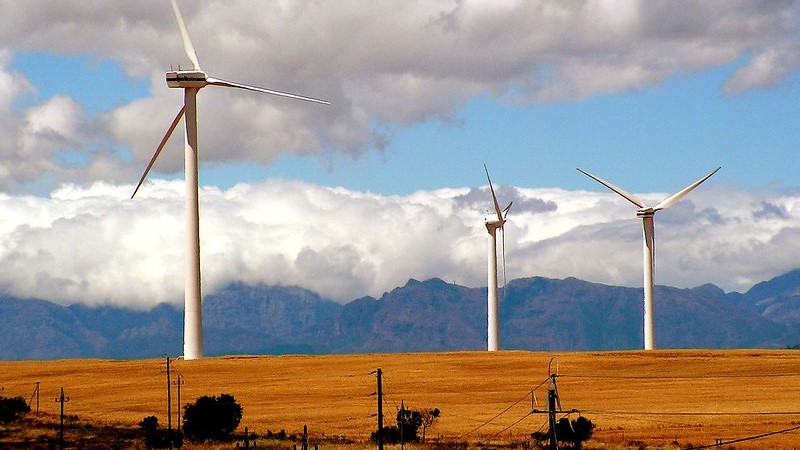South Africa is proposing to deepen its emissions cuts by almost a third in 2030, according to a draft climate plan published last week.
The government launched a consultation on its updated climate plan to run until the end of May, with a view to submit a final document to the UN ahead of the Cop26 climate talks in Glasgow, UK, in November.
Under the draft plan, South Africa will limit its annual greenhouse gas emissions to 398-440 million tonnes of CO2 equivalent by 2030. This cuts emissions 28% compared with its 2015 pledge, which capped annual emissions at 614 MtCO2.
It relies on “a very ambitious power sector investment plan” and the implementation of a green transport strategy, energy efficiency programmes and a carbon tax to meet the goal.
“We are not putting up excuses not to do things because there’s Covid-19 pandemic,” Gwede Mantashe, minister of mineral resources and energy, told a summit on climate and development hosted by the UK last week.
Describing the energy transition as “a journey”, Mantasha said: “It is not going to be the stroke of a pen [that] switches off coal power stations and then moves to renewables.”
India calls out rich nations for setting net zero goals over robust short-term targets
Deborah Ramalope, an analyst at Climate Analytics and a former member of the South African delegation to UN climate talks, said the draft plan was “much stronger” than its 2015 commitments but left room for greater ambition.
It is “still not aligned with the Paris Agreement temperature goal” of limiting heating to 1.5C by the end of the century, she told Climate Home News.
Wanjira Mathai, regional director for Africa at the World Resources Institute, applauded the proposed target which would put the country’s efforts in line with limiting temperature to 2C, according to benchmarks by Climate Action Tracker.
She welcomed the inclusion of policies to cope with intensifying climate impacts such as early warning systems, climate-resilient development planning, improved governance, and support for research.
South Africa estimates it will need $8 billion a year from the international community by 2030 to finance its decarbonisation and adaptation efforts – more than three times what it received in recent years. Of the climate finance it accessed in 2018-19, 89% was in loans.
Climate news in your inbox? Sign up here
South Africa’s tighter target was made possible by lower-than-expected greenhouse gas emissions over the past 10 years and a drop in emission intensity, according to the government document.
Saliem Fakir, South-Africa based executive director for the Africa Climate Foundation, said this can be explained through a growth of the service sector and the decline of carbon-intensive heavy-industries.
A sharp rise in electricity tariffs had increased the cost burden on companies and spurred improvements in energy efficiency, he said.
The improved climate plan is “not the result of true ambition,” Fakir told Climate Home News, but rather the side effect of an economic shift towards services.
“This has got nothing to do with an active strategy to bring emissions down. Emissions are still driven by coal,” he added.
State-owned utility Eskom’s coal plants generated 86% of the country’s electricity in 2020, making South Africa the most coal-reliant among G20 economies.
The updated climate plan identifies the electricity sector as a decarbonisation priority for the next decade, while ensuring communities dependent on coal for their livelihoods are guaranteed economic opportunities.
South Africa aims to reach net zero emissions in 2050 – while still burning coal
Campaigners and analysts say the country could decarbonise faster, but is held back by an arbitrary cap on renewable energy deployment. Under its 2019 electricity supply strategy, the government allows for another 1,500MW of coal power capacity to be installed this decade, while restricting solar installations to 1,000MW a year and wind to 1,600MW.
“That is our Achilles heel of climate ambition,” Alex Lenferna, secretary of the Climate Justice Coalition, a network of civil society groups in South Africa, told Climate Home News. “It’s also pretty hard for South Africa to secure green finance when we’re planning on building more coal.”
Hartmut Winkler, of the University of Johannesburg, told Climate Home News there was “no need for a renewable cap” which was creating an artificial barrier to decarbonisation.
“If there was a very clear signal that this country was going to push renewables, there would be absolutely no lack of interests from investors,” he said.
Fakir said the government has sought to keep the coal sector on side with a compromise that still allows for a significant amount of coal in the power mix.
While the government has approved a long-term vision to achieve carbon neutrality by 2050, the plan would still allow the country to burn coal with no exit date yet agreed.
“There is a lot of politics going on in the coal sector and vested interests. The term ‘coal mafia’ is used quite often to describe opaque purchasing contracts,” Winkler added.
Meanwhile, a fifth procurement round for 1,600 MW of onshore wind and 1,000 MW of solar energy was announced earlier this month – two years later than planned.
As a result of delayed renewable deployment and ageing coal power stations increasingly taken offline for maintenance, South Africa is experiencing periodic power cuts that Eskom says could last for the next five years.
